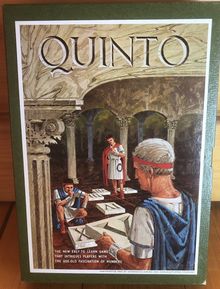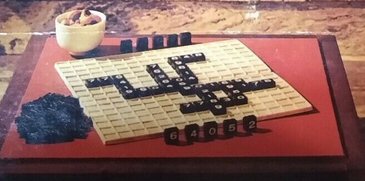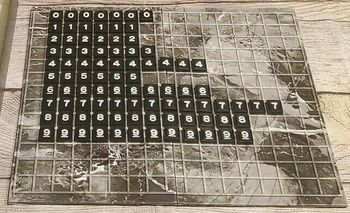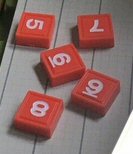Quinto (grid game)
- See also: Quinto (card game)
Quinto is a board game, sometimes also called Game of Fives, suitable for one to four players. It's board and rules resemble those of Scrabble, except the tiles are numbers rather than letters. The vertical and horizontal total must always be a multiple of five, and five is the maximum tiles that can be in a contiguous run. Each play can be horizontal or vertical, but not both. The score of each play, as in Scrabble, is the sum of all numerical totals of each vertical or horizontal run created by the play. Unplayed game tiles are kept face-down until used; each player always has five tiles ready to play, and draws after playing to replenish their supply of five tiles. Play proceeds until all tiles are used up.
Four versions of Quinto
The original board game was sold in the 1960's by 3M (as a "3M Bookshelf" game), and is no longer being manufactured. As of 2020, a lively online trade exists in old, used Quinto board games. There were three editions of the board game, some of which are still being traded; before buying one of these, it is important to verify that all the expected tiles are still present in the game. The original game with wooden tiles seems to be extremely rare. A fourth version has been available online since 2018.
1964 edition, 83 black wooden tiles, 15x15 grid
Per this Boardgamegeek online post, there was an original edition from 1964 which used a 15 x 15 grid, with black wooden tiles, and had only 83 tiles. For the numbers 0 through 6, there was one less tile than the later, plastic editions. The numerical distribution for the eight-two wooden tiles was as follows[1]:
Tile : how many (83) 0 : six 1 : five 2 : five 3 : six 4 : nine 5 : five 6 : nine 7 : fourteen 8 : twelve 9 : twelve
1964 edition, 90 black plastic tiles, 13x17 grid
The 1964 edition had 90 black tiles, and a gray, or marbled gray, game board with 13 rows and 17 columns. The numerical distribution for the ninety tiles was as follows[2]:
Tile : how many (90) 0 : seven 1 : six 2 : six 3 : seven 4 : ten 5 : six 6 : ten 7 : fourteen 8 : twelve 9 : twelve
1968 edition, 90 brown plastic tiles, 12x18 grid
The 1968 edition has 90 brown tiles and 5 red tiles, and a white 12 x 18 game board (one more column than the 1964 plastic game). In this version of the game, the red tile 5 is always used in the first play of the game, starting in the center of the board. This means the game is actually played with 91 tiles, rather than 90 as per the 1964 plastic edition. The other four red tiles (6,7,8, and 9) are drawn by players to decide who plays first (the player whose number is closest to 5) but are not used during game play. Note that the til distributions in the two editions are similar, while game board size varies. The numerical distribution for the tiles in the 1968 edition is as follows[3]:
Brown Tiles : 90, distribution exactly as per the plastic black tiles in the 1964 edition
Red Tiles: how many (5)
5 : one
6 : one
7 : one
8 : one
9 : one
Online game, 90 tiles, 13x13 grid; AI opponent
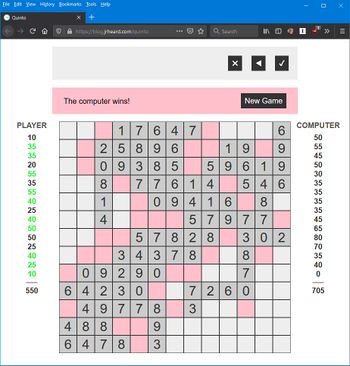
In 2018, programmer J. R. Heard created an addictive online version of Quinto. Heard provided an "AI opponent" that is virtually unbeatable by humans, and also play hints that help a human increase their skills. The online game uses the 90-tile numerical distribution of the 1964 edition of the Quinto board game, but its board has four fewer vertical columns, making it a 13x13 grid. The game is powered by Javascript, which means it executes locally in your web browser and the game web page can be saved locally on your computer for offline use. The details about the source code are also online.
Notes
- ↑ Boardgamegeek.com has this long thread, which reaches a community consensus about the expected tile distribution in the different editions.
- ↑ Same as Note 1 above
- ↑ Same as Note 1 above
